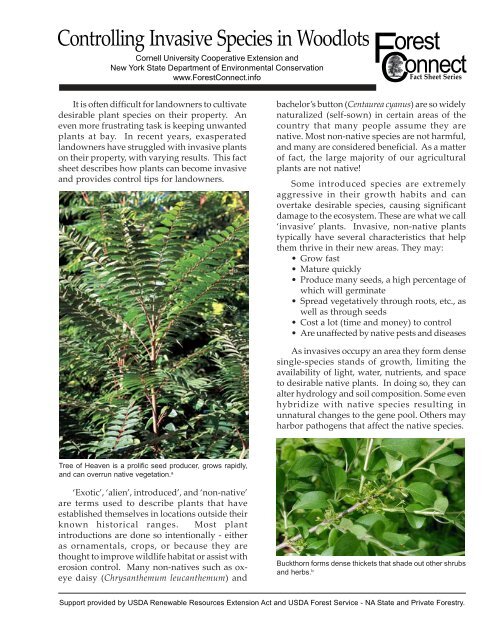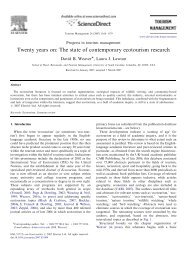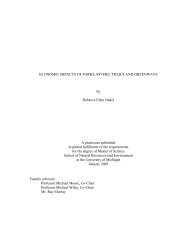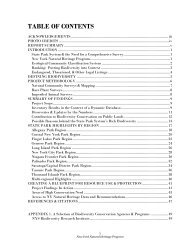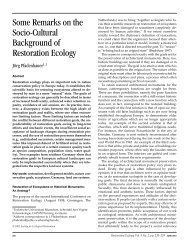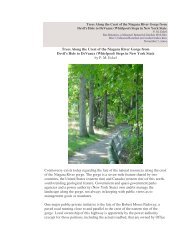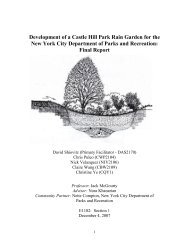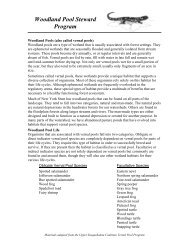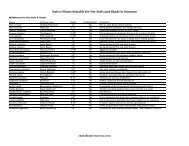Controlling Invasive Species in Woodlots - Wild Ones Niagara
Controlling Invasive Species in Woodlots - Wild Ones Niagara
Controlling Invasive Species in Woodlots - Wild Ones Niagara
Create successful ePaper yourself
Turn your PDF publications into a flip-book with our unique Google optimized e-Paper software.
<strong>Controll<strong>in</strong>g</strong> <strong>Invasive</strong> <strong>Species</strong> <strong>in</strong> <strong>Woodlots</strong><br />
Cornell University Cooperative Extension and<br />
New York State Department of Environmental Conservation<br />
www.ForestConnect.<strong>in</strong>fo<br />
F orest<br />
C Fact<br />
onnect<br />
Sheet Series<br />
It is often difficult for landowners to cultivate<br />
desirable plant species on their property. An<br />
even more frustrat<strong>in</strong>g task is keep<strong>in</strong>g unwanted<br />
plants at bay. In recent years, exasperated<br />
landowners have struggled with <strong>in</strong>vasive plants<br />
on their property, with vary<strong>in</strong>g results. This fact<br />
sheet describes how plants can become <strong>in</strong>vasive<br />
and provides control tips for landowners.<br />
bachelor’s button (Centaurea cyanus) are so widely<br />
naturalized (self-sown) <strong>in</strong> certa<strong>in</strong> areas of the<br />
country that many people assume they are<br />
native. Most non-native species are not harmful,<br />
and many are considered beneficial. As a matter<br />
of fact, the large majority of our agricultural<br />
plants are not native!<br />
Some <strong>in</strong>troduced species are extremely<br />
aggressive <strong>in</strong> their growth habits and can<br />
overtake desirable species, caus<strong>in</strong>g significant<br />
damage to the ecosystem. These are what we call<br />
‘<strong>in</strong>vasive’ plants. <strong>Invasive</strong>, non-native plants<br />
typically have several characteristics that help<br />
them thrive <strong>in</strong> their new areas. They may:<br />
• Grow fast<br />
• Mature quickly<br />
• Produce many seeds, a high percentage of<br />
which will germ<strong>in</strong>ate<br />
• Spread vegetatively through roots, etc., as<br />
well as through seeds<br />
• Cost a lot (time and money) to control<br />
• Are unaffected by native pests and diseases<br />
As <strong>in</strong>vasives occupy an area they form dense<br />
s<strong>in</strong>gle-species stands of growth, limit<strong>in</strong>g the<br />
availability of light, water, nutrients, and space<br />
to desirable native plants. In do<strong>in</strong>g so, they can<br />
alter hydrology and soil composition. Some even<br />
hybridize with native species result<strong>in</strong>g <strong>in</strong><br />
unnatural changes to the gene pool. Others may<br />
harbor pathogens that affect the native species.<br />
Tree of Heaven is a prolific seed producer, grows rapidly,<br />
and can overrun native vegetation. a<br />
‘Exotic’, ‘alien’, <strong>in</strong>troduced’, and ‘non-native’<br />
are terms used to describe plants that have<br />
established themselves <strong>in</strong> locations outside their<br />
known historical ranges. Most plant<br />
<strong>in</strong>troductions are done so <strong>in</strong>tentionally - either<br />
as ornamentals, crops, or because they are<br />
thought to improve wildlife habitat or assist with<br />
erosion control. Many non-natives such as oxeye<br />
daisy (Chrysanthemum leucanthemum) and<br />
Buckthorn forms dense thickets that shade out other shrubs<br />
and herbs. b<br />
Support provided by USDA Renewable Resources Extension Act and USDA Forest Service - NA State and Private Forestry.
If you currently have <strong>in</strong>vasive plant species<br />
grow<strong>in</strong>g on your land, recommendations for<br />
control are listed below. Whichever method you<br />
decide to use, realize that controll<strong>in</strong>g <strong>in</strong>vasives<br />
is an uphill challenge and requires patience and<br />
persistence.<br />
Multi-flora rose can form dense thickets <strong>in</strong> old fields and<br />
forests, prevent<strong>in</strong>g other species from grow<strong>in</strong>g. c<br />
What can landowners do to combat <strong>in</strong>vasive<br />
plants?<br />
Learn what plants are already known to be a<br />
problem <strong>in</strong> your area, and avoid plant<strong>in</strong>g them.<br />
Some, such as purple loosestrife (Lythrum<br />
salicaria), are still available as landscape plants<br />
and are sold or promoted <strong>in</strong> nurseries. It is best<br />
to err on the side of caution - if you have any<br />
doubts about a certa<strong>in</strong> type of vegetation, don’t<br />
plant it!!<br />
Consider plant<strong>in</strong>g native trees and shrubs.<br />
Native plants occur naturally <strong>in</strong> the region <strong>in</strong><br />
which they evolved. In the United States, native<br />
plants are usually def<strong>in</strong>ed as those plants that<br />
have been present s<strong>in</strong>ce the time of European<br />
contact. Because native plants have evolved and<br />
adapted to local conditions, they are vigorous<br />
and hardy and able to survive w<strong>in</strong>ter cold and<br />
summer heat. Once established, they require<br />
little or no irrigation or fertilization, thereby<br />
sav<strong>in</strong>g you energy and water. Native plants also<br />
provide food and shelter for birds, butterflies,<br />
and other desirable wildlife. However, even<br />
some native plants can be quite aggressive so be<br />
sure you understand the growth habits of any<br />
native plants you decide to use on your property.<br />
Vigor and hard<strong>in</strong>ess are characteristics native<br />
plants share with <strong>in</strong>vasive plants, so be sure you<br />
understand the growth habits of any native<br />
plants you decide to use <strong>in</strong> your woodland –<br />
some are quite aggressive!<br />
Oriental bittersweet is an aggressive plant that grows over<br />
other vegetation at all levels <strong>in</strong> the forest. d<br />
Trees, Shrubs and V<strong>in</strong>es:<br />
• The simplest method to remove woody<br />
plants is to cut them down. Once may be<br />
enough, but most will sucker from the<br />
stump or roots, even those that generally<br />
do not reproduce vegetatively. Check for<br />
sucker<strong>in</strong>g every year, if not more often.<br />
• Dig up stumps/roots.<br />
• Do not plant <strong>in</strong>vasive plants near woodland<br />
areas, and resist the urge to buy the many<br />
<strong>in</strong>vasives that are still available <strong>in</strong> the<br />
nursery trade.<br />
• Herbicides or a comb<strong>in</strong>ation of cutt<strong>in</strong>g and<br />
herbicides is an option. Some of the most<br />
effective herbicides for controll<strong>in</strong>g <strong>in</strong>vasive<br />
species must be applied by a licensed<br />
pesticide applicator. Call your local Cornell<br />
Cooperative Extension office for<br />
recommendations.
Common Woodland <strong>Invasive</strong> Plants <strong>in</strong> New York:<br />
Name Habitat Spread Control<br />
Trees<br />
Norway Maple<br />
Acer platanoides<br />
Tree of Heaven<br />
Ailanthus altissima<br />
White Poplar<br />
Populus alba<br />
Black Locust<br />
Rob<strong>in</strong>a pseduoacacia<br />
Forest Edge. Fencerows<br />
Full Sun to Full Shade<br />
Forest Edge and Gaps,<br />
Disturbed areas,<br />
Zone 5 and warmer<br />
Full sun, Forest Edges, Wetland<br />
Edges<br />
Forest Edge and Interior, Full<br />
Sun to Full Shade, Disturbed<br />
Sites<br />
By Seed (w<strong>in</strong>d)<br />
By Seed and Root<br />
suckers.<br />
Root Suckers<br />
Root Suckers<br />
(primarily) and Seed<br />
Avoid plant<strong>in</strong>g near woodlands<br />
Avoid plant<strong>in</strong>g near<br />
woodlands; hand‐pull or dig up<br />
Avoid plant<strong>in</strong>g near<br />
woodlands;<br />
Avoid plant<strong>in</strong>g. Dig up<br />
seedl<strong>in</strong>gs or apply herbicide<br />
Shrubs<br />
Barberry<br />
Berberis thunbergii, vulgaris<br />
Forest Interior and Edge, Full<br />
Sun to Full Shade<br />
By Seed (birds)<br />
Cut Down/ Dig up or apply<br />
herbicide<br />
Autumn Olive<br />
Elaeagnus umbellata<br />
Burn<strong>in</strong>g Bush<br />
Euonymus alatus<br />
Privet<br />
Ligustrum obtusifolium<br />
Honeysuckle<br />
Lonicera tatarica, maackii,<br />
morrowii<br />
Buckthorn<br />
Rhamnus cathartica,<br />
frangula<br />
Multiflora Rose<br />
Rosa multiflora<br />
Open areas, Forest Edge<br />
Full Sun to Full Shade<br />
Full Sun to Full Shade, Forest<br />
Edge and Interior<br />
Full Sun to Full Shade, Forest<br />
Edge and Interior<br />
Full Sun to Full Shade, Upland<br />
and Wetland<br />
By Seed (birds)<br />
By Seed (birds) and<br />
Root Suckers (form<br />
thickets)<br />
By Seed (birds)<br />
By Seed (birds)<br />
Stump Sprouts<br />
By Seed (birds)<br />
Avoid plant<strong>in</strong>g <strong>in</strong> woodlands;<br />
Cut Down/ Dig Up<br />
Avoid plant<strong>in</strong>g <strong>in</strong> woodlands.<br />
Cut Down/ Dig up; herbicide<br />
Avoid plant<strong>in</strong>g; Cut Down/ Dig<br />
up; herbicide<br />
Cut Down/ Dig up; herbicide<br />
Same as above<br />
Full Sun to Full Shade By Seed (birds) Same as above<br />
V<strong>in</strong>es<br />
Porcela<strong>in</strong> Berry<br />
Ampelopsis Brevipedunculata<br />
Oriental Bittersweet<br />
Celastrus orbiculatus<br />
Full to Partial Sun, Forest Edge<br />
and Gaps<br />
Full Sun to Partial Shade<br />
Forest Edge and Gaps<br />
By Seed (birds,<br />
mammals), Stems<br />
and Roots.<br />
By Seed (birds,<br />
humans)<br />
Hand‐pull; herbicide<br />
Hand‐pull; herbicide<br />
Japanese Honeysuckle<br />
Lonicera japonica<br />
Full Sun to Full Shade<br />
Forest Edge<br />
By Seed (birds)<br />
Hand‐pull; herbicide<br />
Forbs<br />
Garlic Mustard<br />
Alliaria petiolata<br />
Purple Loosestrife<br />
Lythrum salicaria<br />
Japanese Knotweed<br />
Polygonum cuspidatum<br />
Full Sun to Full Shade<br />
Disturbed Soils, Biennial<br />
Full Sun to Partial Shade,<br />
Wetland and Upland Sites,<br />
Perennial<br />
Full Sun to Full Shade, almost<br />
any site, Perennial<br />
By Seed<br />
By Seed,<br />
Underground Stems<br />
By Seed, and Roots<br />
Hand‐pull<br />
Hand‐pull; Galerucella pusilla<br />
and calmariensis leaf‐eat<strong>in</strong>g<br />
beetles<br />
Hand‐Pull, Dig Up Roots,<br />
Smother, Herbicide
Burn<strong>in</strong>g Bush outcompetes native species <strong>in</strong><br />
woodlands and fields. d<br />
Forbs:<br />
Annuals:<br />
• Pull by hand or apply an herbicide before<br />
they go to seed.<br />
• Repeat every year until the seed bank <strong>in</strong><br />
the soil has been exhausted.<br />
Perennials:<br />
• Pull by hand repeatedly throughout the<br />
grow<strong>in</strong>g season; many will resprout from<br />
the roots.<br />
• Dig out roots if you can get to them.<br />
Repeated pull<strong>in</strong>g will dim<strong>in</strong>ish the<br />
carbohydrate supply <strong>in</strong> the roots over time.<br />
• Smother with non-permeable plastic. Cover<br />
area <strong>in</strong> early spr<strong>in</strong>g and leave for two or<br />
more grow<strong>in</strong>g seasons.<br />
• Some herbicides can be used, contact<br />
Cornell Cooperative Extension for a list.<br />
• Cont<strong>in</strong>ue control methods until seed bank<br />
<strong>in</strong> the soil has been exhausted.<br />
Garlic mustard can take over the forest floor.<br />
Autumn Olive grows rapidly and thrives <strong>in</strong> poor soils, shades<br />
out other plants, and is difficult to eradicate. e<br />
Hope for the future: biological control<br />
A primary reason exotic <strong>in</strong>vasive species are<br />
so pervasive is that they have few, if any, diseases<br />
or pests <strong>in</strong> their new environment. Researchers<br />
have had some success <strong>in</strong> f<strong>in</strong>d<strong>in</strong>g and<br />
propagat<strong>in</strong>g native or non-native fungi, viruses,<br />
mites and/or <strong>in</strong>sects that help control the target<br />
<strong>in</strong>vasive species, without pos<strong>in</strong>g a threat to<br />
desirable plants. Purple loosestrife has been<br />
successfully controlled <strong>in</strong> this manner <strong>in</strong> many<br />
sites. Research is underway to f<strong>in</strong>d biological<br />
control agents for garlic mustard, multi-flora<br />
rose, kudzu, and other major non-native<br />
<strong>in</strong>vasives of old fields and forests <strong>in</strong> the<br />
northeast.<br />
Web Pages of Interest<br />
Ecology and Management of <strong>Invasive</strong> Plants<br />
http://www.<strong>in</strong>vasiveplants.net/<br />
USDA Forest Service <strong>Invasive</strong> <strong>Species</strong> http://<br />
www.fs.fed.us/<strong>in</strong>vasivespecies/<br />
<strong>Invasive</strong> Plant Council of New York: http://<br />
www.ipcnys.ene.com/<br />
<strong>Invasive</strong> Plants of New England: http://<br />
<strong>in</strong>vasives.eeb.uconn.edu/ipane/<br />
<strong>Invasive</strong> and Exotic <strong>Species</strong>: http://<br />
www.<strong>in</strong>vasive.org/<br />
Prepared by Rebecca Hargrave, Emily Selleck, and Kelly Fallone with support of<br />
Cornell Cooperative Extension of Chenango, Essex, and Cayuga Counties. Edited and compiled by<br />
Kristi L. Sullivan, Peter J. Smallidge and Gary R. Goff, Department of Natural Resources, Ithaca, NY. 2006.<br />
Photos from: www.forestryimages.org - a,b,d James H. Miller, USDA Forest Service, e J. Mehrhoff, University of Connecticut, c James R.<br />
Allison, Georgia Department of Natural Resources, f Chris Evans, The University of Georgia.


